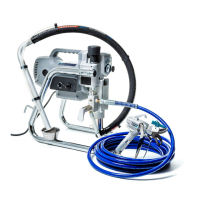
Do you have a question about the QTech QT190 and is the answer not in the manual?
| Max. Working Pressure | 3000 psi |
|---|---|
| Voltage | 120 V |
| Model | QT190 |
| Type | Airless |
| Motor Type | Electric |
| Power Source | Electric |
| Nozzle Size | 0.015 in |
Troubleshoot motor not running, including power and pressure checks.
Address pump not cycling or priming issues.
Diagnose insufficient pressure or sudden loss of spray pressure.
Resolve issues with bad quality or uneven spray patterns.
Suitable coatings for the QT190 airless sprayer.
Key performance metrics like flow rate and maximum tip.
Motor, weight, and warranty details of the sprayer.
List of items supplied with the QT190 sprayer.
Product codes for different voltage models.
Guidelines for maintaining a safe work environment.
Ensure proper grounding and use matching plugs for safety.
Prevent electric shock by avoiding contact with grounded objects.
Keep sprayer dry and protect the power cord from damage.
Stay alert and use common sense when operating the sprayer.
Always wear eye protection and other safety gear.
Ensure the switch is off before plugging in and maintain balance.
Avoid loose clothing or jewelry near moving parts.
Only qualified technicians should service the sprayer.
Treat the unit with extreme caution due to high pressure.
Skin injection is a serious medical emergency.
Avoid sparks and ignition sources near the sprayer.
Wear respirators, eye protection, and protective clothing.
Do not use halogenated hydrocarbon solvents.
Prevent sparks from igniting vapors by proper placement.
Do not plug/unplug electrical cords in spray areas.
Seek emergency care if fluid penetrates skin.
Never point the gun at body parts, avoid covering the tip.
Always follow pressure relief, use tip guards, lock trigger.
Ensure safety devices work, tighten connections, no smoking.
Keep area clear, ventilated, and free of flammables.
Safety for gun usage, including safety lock and tip removal.
The tip guard prevents accidental contact with the spray tip.
Caution when cleaning or changing spray tips.
Know fluid hazards, wear protective gear, and store/dispose properly.
Use correct, undamaged hoses; do not tape or modify them.
Grounding reduces risk of static sparking, fire, and explosion.
Ground sprayer, hoses, gun, and pails; use proper extension cords.
Safety measures for flammable paints and thinners.
Steps to prevent static discharge during flushing.
Avoid solvents with low flash points and use minimum pressure.
Connect the hose to the pump and spray gun.
Flushing and preparing a new sprayer before first use.
Procedures for flushing when changing colors or paint bases.
Detailed steps to safely relieve pressure in the system.
Situations requiring flushing, including cleanup and storage.
How to flush for oil-based, water-based paints, and after storage.
Connecting components, checking electrics, and priming.
Fine-tuning pressure for optimal atomization and efficiency.
Guidance on spray distance, motion, and overlap.
Safety on bucket spraying, injection prevention, and shutdown.
Attaching the gun and using its safety latch.
How to assemble the spray tip and clear blockages.
Maintenance for the spray gun's internal filter.
Factors influencing spray tip selection for different paints.
How spray tip design affects pattern width and coverage.
Identifying worn tips and the reasons for replacement.
Step-by-step guide for cleaning the sprayer.
Essential daily tasks like lubrication and inspection.
Signs that indicate the pump packings need replacement.
Instructions for safely removing the pump unit.
Steps for replacing worn pump packings.
